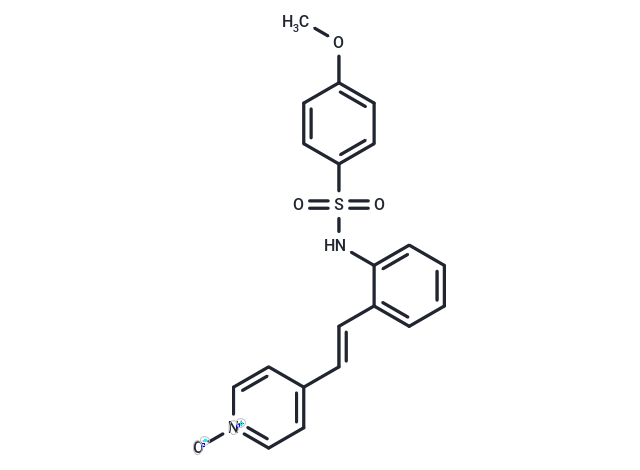Shopping Cart
- Remove All
 Your shopping cart is currently empty
Your shopping cart is currently empty

HMN-176 is a stilbene derivative which inhibits mitosis, interfering with polo-like kinase-1 (plk1).

| Pack Size | Price | Availability | Quantity |
|---|---|---|---|
| 1 mg | $36 | In Stock | |
| 2 mg | $51 | In Stock | |
| 5 mg | $80 | In Stock | |
| 10 mg | $122 | In Stock | |
| 25 mg | $198 | In Stock | |
| 50 mg | $369 | In Stock | |
| 100 mg | $549 | In Stock | |
| 500 mg | $1,190 | In Stock | |
| 1 mL x 10 mM (in DMSO) | $72 | In Stock |
| Description | HMN-176 is a stilbene derivative which inhibits mitosis, interfering with polo-like kinase-1 (plk1). |
| In vitro | HMN-176 at a concentration of 2.5 μM significantly prolongs mitosis in hTERT-RPE1 and CFPAC-1 cell lines, independent of its impact on microtubule polymerization. Concentration-dependently, it inhibits aster formation at doses of 2.5, 0.25, and 0.025 μM. At varying concentrations (0.1, 1.0, or 10.0 µg/mL), HMN-176 exhibits inhibitory effects on breast, non-small-cell lung, and ovarian cancer specimens, with significant activity observed in 63% of breast, 67% of non-small cell lung, and 57% of ovarian tumor specimens treated at 10.0 µg/mL. It shows considerable cytotoxicity across different tumor types from various organs, with a mean IC50 value of 118 nM, indicating a broad cytotoxic effect. Furthermore, a 3 μM treatment of HMN-176 reduces MDR1 mRNA expression by 56%, although it does not significantly affect residual promoter activity. |
| In vivo | HMN-176 prevents spindle assembly and meiosis in Spisula oocytes by inhibiting centrosome-dependent MT nucleation, i.e., aster formation. Oocytes treated with 0.25 μM HMN-176 undergoes GVBD, but asters or spindles fails to form, even after prolonged periods[1]. After p.o. of HMN-214 to male rats, the prodrug is not detected in the plasma, while plasma levels of HMN-176 peaks at 2 h and gradually decreases thereafter[3]. |
| Cell Research | Cells to be tested are seeded into a 96-well microplate at a density of 3 ×103-1×104 cells/well. Drugs are added the next day and the plate is incubated for 72 h at 37 °C in a humidified incubator (5% CO2, 95% air). The inhibition of growth is measuredby the MTT assay, and the concentration required to produce 50% inhibition of growth (IC50) calculated by the Scansoft 96 software program. The IC50 values for HMN-176 andreference agents are presented. Briefly, for each compound the mean IC50 value for all cell lines tested is calculated and the difference between the individual IC50 values and the mean IC50 value (log10) displayed by a bar projecting to the right or left of the mean. The resistance index is calculated as (IC50 value for drug-resistant cell line)/(IC50 for parent cell line). |
| Molecular Weight | 382.43 |
| Formula | C20H18N2O4S |
| Cas No. | 173529-10-7 |
| Smiles | COc1ccc(cc1)S(=O)(=O)Nc1ccccc1\C=C\c1cc[n+]([O-])cc1 |
| Relative Density. | 1.24 g/cm3 (Predicted) |
| Storage | Powder: -20°C for 3 years | In solvent: -80°C for 1 year | Shipping with blue ice. | |||||||||||||||||||||||||||||||||||
| Solubility Information | DMSO: 50 mg/mL (130.74 mM) | |||||||||||||||||||||||||||||||||||
Solution Preparation Table | ||||||||||||||||||||||||||||||||||||
DMSO
| ||||||||||||||||||||||||||||||||||||

Copyright © 2015-2024 TargetMol Chemicals Inc. All Rights Reserved.